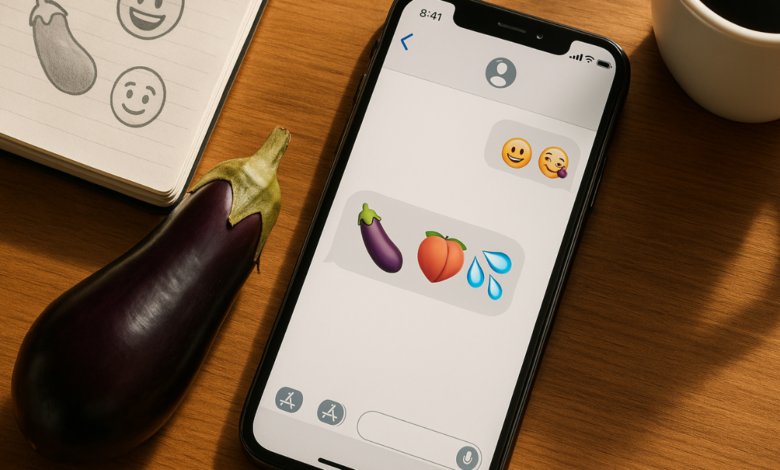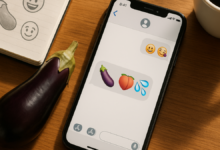What Does an Eggplant Emoji Mean? Context, Culture, and Hidden Meanings Explained

Curious what does an eggplant emoji mean. Learn the real meanings, the role of context and consent, when it is harmless food talk, and how to respond with confidence and respect.
The purple vegetable sits in keyboards across the world, looking innocent and a little goofy. Yet anyone who has spent time in group chats, comment threads, or late night messages knows it can carry a meaning that goes far beyond produce. If you have ever paused and wondered what does an eggplant emoji mean, you are not alone. It can be flirty, funny, bold, or wildly out of place depending on who sends it, where it appears, and the tone of the conversation.
At heart, the eggplant is both a real food and a cultural wink. The shape invites innuendo, and internet culture happily ran with it. Still, context is everything. A chef sharing a recipe might absolutely mean the vegetable, while a friend replying to a selfie with the same icon probably does not mean ratatouille. This guide breaks down the layers, the etiquette, and the smart ways to read and use it so you can decode the signal without stepping on a social rake.
The Short Answer People Want And The Longer Truth
In the most common social setting, the eggplant acts as a suggestive stand in for a private body part. That is the default meaning many readers jump to, especially when it shows up alone, in a flirt, or next to other spicy icons. If you were searching what does an eggplant emoji mean because it popped up in a playful chat, the implied message is likely not about dinner.
The longer truth is that meaning is negotiated in every conversation. Friends who joke freely might toss it around with zero awkwardness. Colleagues on a team chat would find it out of bounds. A cooking blogger can post an actual aubergine and nobody blinks. Same picture, different setting, different vibe. Think of the emoji as a prop; the stage and script decide the role.
How The Eggplant Picked Up Its Reputation
Visual language thrives on resemblance, and the eggplant’s rounded shape and glossy finish made it a perfect candidate for innuendo. Social platforms amplified that association through memes, reaction posts, and running jokes. Over time the joke hardened into a norm: the icon became shorthand for adult themes in casual spaces.
That shift shows how internet communities create shared dictionaries. The keyboard did not arrive with a label that says suggestive. People endowed it with that energy through repetition, remixing, and viral humor. When a meaning gets repeated enough, it sticks, even when the original joke fades from memory.
What Does An Eggplant Emoji Mean In Daily Chats
In flirtatious threads, the icon often signals desire or draws attention to a suggestive topic. It might appear with playful faces, water drops, or a tongue, which strengthens the non food reading. Emojis can work like punctuation, softening a message or nudging it toward a playful tone. Here, the eggplant nudges the message toward adult humor or outright flirtation.
In friendly banter, the same icon can be comedic flair. People use it to mock their own thirst, to exaggerate a reaction, or to satirize an over the top comment. In that role, it functions the way a laugh track would in a sitcom, telling everyone to read the line as a joke. The key is that the group understands the bit and nobody is caught off guard.
When The Eggplant Is Just A Vegetable
In food chats, recipe reels, or grocery lists, the literal reading still wins. A home cook might share a photo of baba ghanoush with eggplant icons as garnish. A nutrition coach can use it to highlight fiber rich meals. Gardeners swap tips and use it as a badge of a good harvest. In these spaces, the culinary meaning is normal and harmless.
If you are unsure, look around the message. Are other food emojis nearby, like tomato, basil, or a skillet. Does the caption mention cooking or a market trip. Are there photos of ingredients. These hints tilt the scale toward a straight, wholesome reading. The safest move is to mirror the sender’s tone and keep replies on the food track unless they steer elsewhere.
The Role Of Context, Relationship, And Consent
Emojis are not private by default. Screenshots exist, group chats have mixed audiences, and workplace channels carry norms and policies. That is why consent and respect matter. Before dropping an eggplant in someone’s inbox, ask whether the relationship supports flirty shorthand and whether the setting is appropriate. If the answer is no or even maybe not, skip it.
On the receiving side, you get to set boundaries. If a message feels unwelcome, you can redirect the chat, ignore the bait, or state your comfort level clearly. Silence is also a signal. No reply is still a reply. Healthy digital etiquette means reading the room and prioritizing comfort over a quick laugh.
Platform Culture And Moderation Can Shift The Meaning
Each app grows its own culture. Some spaces lean loud and meme heavy, others lean professional. Community guidelines also shape behavior, especially around sexual content and harassment. In a community with stricter rules, the eggplant carries extra risk and can be removed or flagged when used to solicit adult content. In looser communities, it slides by as cheeky humor.
Because moderation norms evolve, the prudent approach is to keep suggestive icons away from public comments and brand accounts unless the brand voice clearly supports mature humor and the audience expects it. Even then, creators often use clever substitutes or visual puns to keep the tone playful without violating rules.
Reading The Signals That Surround The Emoji
The icons around it matter. Paired with water drops, tongue, or a devil face, the eggplant leans heavily into suggestive territory. Paired with a chef’s hat, herbs, or a pot, it leans toward food. A lone eggplant after a thirst trap photo will be read differently than the same icon in a farmers’ market post.
Text matters too. If the line is coy, flirty, or teasing, the icon amplifies that tone. If the line is descriptive, as in a caption about roasting vegetables, the icon acts like a decorative bullet point. Think of the eggplant as a chord that harmonizes with whatever sentence plays around it.
Safer Substitutes And Playful Alternatives
If you want to keep a message light without crossing lines, you can swap the eggplant for more neutral expressions. Hearts are flirtatious without being explicit. Fire signals admiration for a look or a fit. Sparkles, stars, and clapping hands praise without innuendo. Even a well placed smile or wink carries warmth while keeping the vibe respectful.
Inside joke communities also develop coded alternatives that dodge moderation while still landing the gag. That can be fun among consenting friends, but it is easy to misread outside the circle. When in doubt, clarity beats clever. A warm compliment in plain language outperforms a cryptic veggie in most situations.
Brand, Creator, And Community Guidelines
If you manage a brand account or build a public persona, consider a layered approach. Define your tone pillars, note where cheeky humor fits, and set red lines for suggestive content. Draft examples of what flies and what does not, then train anyone who posts on behalf of the brand to follow the playbook. It is easier to keep trust than to rebuild it after a misstep.
Creators can also plan for platform variation. A short, spicy joke might work in private stories but feel off in feed posts. Comments live longer than ephemeral messages. Partnerships add another layer, since sponsors often expect all ages friendly captions. The eggplant may be funny in a private chat and off brand on a sponsored post.
Teaching Teens And Supporting Healthy Digital Habits
Parents, guardians, and educators navigate an online world where slang evolves quickly. A calm, curious approach works better than alarm. Ask what students see in their feeds, what symbols show up, and how they interpret them. Share guidelines about respect, consent, and the permanence of screenshots. Equip them to handle pressure with simple scripts for saying no.
Teens are savvy. Many already know the eggplant’s reputation and can joke without harm among friends. The aim is not to ban icons but to encourage thoughtful choices and awareness of power dynamics. A symbol can be harmless in a peer chat and uncomfortable when used by someone with authority. Nuance is the skill to practice.
A Quick Guide To Common Contexts
Below is a simple map to help you decode the moment. Treat it as a cue card, not a law. When uncertain, ask for clarity or default to the most respectful reading.
| Situation | Likely Meaning | Better Reply |
|---|---|---|
| Private flirty chat between consenting adults | Suggestive humor or desire | Mirror the tone only if you are comfortable |
| Group chat with mixed company | Risk of awkwardness or offense | Shift to neutral jokes or skip it |
| Food post, recipe, or garden talk | Literal vegetable | Share cooking tips or reactions about the dish |
| Workplace or class channel | Out of bounds | Keep messages professional and clear |
| Public comment under a selfie | Flirt or thirst joke | Compliment respectfully without innuendo |
Style Tips If You Choose To Use It Anyway
Keep the ratio of text to emoji in your favor. A line of icons with no words is easy to misread. A short sentence with a single icon is easier to interpret. Use the eggplant as emphasis, not as the entire message.
Pair thoughtfully. If you must lean spicy, remember that a combo can push the tone past playful into explicit. If you intend a food meaning, surround it with culinary cues to prevent confusion. Your goal is to help the reader arrive at the intended meaning without a detour.
How To Respond When The Meaning Feels Murky
You can ask a light clarifying question. A simple line like what did you mean by that keeps things open and avoids assumptions. If the chat veers into a lane you do not want, a direct boundary works: let’s keep this friendly or let’s talk about the recipe. Most people will adjust when you set a clear line.
If the sender doubles down after a boundary, you can mute, block, or report in spaces that offer those tools. Protecting your comfort is not rude. You are never obligated to match someone else’s tone, especially when the tone turns uncomfortable.
What Does An Eggplant Emoji Mean Across Cultures
Icons travel across languages, but humor does not always cross borders cleanly. In some places the eggplant remains a kitchen staple with zero suggestive baggage. In global teams or international communities, assume less and ask more. A quick note like are you talking about the veggie can rescue a conversation before it goes sideways.
Memes also carry local references. A joke that lands in one region might puzzle another. When you post for a wide audience, favor clarity, add context, and avoid relying on insider symbols to carry your main point.
A Note On Accessibility And Inclusivity
Not everyone reads icons the same way. Screen readers announce emojis by their official names, which can create jarring moments if your caption depends on euphemism. If you write for an inclusive audience, add a short phrase that makes the intent clear even without the visual. Clear writing helps everyone, and it reduces the chance of misinterpretation.
Inclusivity also means respecting different comfort levels. Some communities love cheeky banter; others prefer straightforward talk. You do not need to use a spicy symbol to be charming, kind, or funny. There are limitless ways to connect with people without relying on innuendo.
Creative, Non Suggestive Uses That Still Feel Fun
The eggplant can decorate vegetable facts, seasonal produce lists, or farm to table posts. It can anchor a color palette in design mood boards. Artists remix it into patterns, stickers, and character art. Teachers use it in language lessons to label foods in a second language. All of these uses keep the symbol bright, playful, and free of baggage.
Treat it like any graphic element. If your story or caption celebrates cooking, gardening, or creativity, it fits. If your message is about people and bodies, think twice and choose a path that keeps everyone comfortable.
Common Myths To Leave Behind
The icon does not always signal explicit intent. People sometimes toss it in without thinking, imitating a meme they only half remember. That is why checking context matters more than jumping to a conclusion. Misunderstandings shrink when we slow down.
Another myth is that using the eggplant is the only way to sound bold or flirty online. Words work. Compliments, humor, and curiosity all build connection without a single emoji. If you lean on symbols to carry the whole mood, your meaning depends on the reader’s assumptions, not your clarity.
Sample Messages And How To Read Them
Loved your roasted veggie reel, that caramelized slice at the end looked amazing
Here the eggplant reads as a culinary accent. The praise is about cooking.
You looked incredible in that new fit
This feels like admiration without innuendo. The writer chose clarity.
Dinner plans later
Without context this is ambiguous. A follow up question can clarify the intent.
Fresh from the garden today, can you believe this color
A literal harvest brag. The tone is wholesome.
What Does An Eggplant Emoji Mean For Parents And Caregivers
If you discover the symbol in a teen’s chat, breathe. Ask open questions about how they see it used. Share your values around respect and consent. Talk about power dynamics, screenshots, and the idea that private jokes can leak into public view. Aim for guidance over panic. The goal is to equip, not to shame.
Offer scripts. Saying I am not into that or not my vibe is a skill. So is changing the subject gracefully. Normalize boundary setting as a sign of confidence, not conflict. When young people feel safe talking with you, they are more likely to ask for help if a chat turns uncomfortable.
For Writers, Social Media Managers, And Community Leads
Document your standards. Decide where playful innuendo fits, if at all. Create sample captions that demonstrate on brand humor without suggestive symbols. Review posts through an accessibility lens and consider how screen readers will describe the emojis you use. If a post depends on a euphemism to be funny, rewrite it so the joke survives with clear language.
Train moderators to watch for patterns rather than single icons. A lone eggplant might be harmless in a food thread. A flood of suggestive icons targeting a user may signal harassment. Encourage gentle nudges first, and reserve hard actions for repeated issues or clear malice.
The Bottom Line
So, what does an eggplant emoji mean. In many casual chats, it signals a suggestive joke. In food spaces, it is a simple vegetable. Everything turns on context, relationship, and intention. If you send it, choose the right place. If you receive it, read the room and respond in a way that protects your comfort. Clarity and consent keep digital spaces fun and kind.
Frequently Asked Questions
Does the eggplant always mean something suggestive
No. In food, gardening, and nutrition posts it usually points to the actual vegetable. In flirty chats it often carries innuendo. Context decides the reading.
Is it appropriate to use in public comments
It depends on the community and your relationship with the poster. Public spaces can include audiences who do not share your humor, so neutral compliments are usually safer.
What does an eggplant emoji mean in private messages
Between consenting adults, it often signals playful desire or a cheeky mood. Make sure both sides are comfortable before using any suggestive emoji.
Can I use it in workplace channels
That is not a good idea. Professional spaces call for clear, non suggestive language. Even as a joke, it can create awkwardness or cross policy lines.
What should I do if someone sends it and I feel uncomfortable
You can ignore it, redirect the topic, or set a boundary with a simple line like let’s keep this friendly. If the behavior continues, use mute, block, or report tools where available.
Conclusion
The purple icon is a small image with a big reputation. When people ask what does an eggplant emoji mean, they are really asking how to read the signals of tone, place, and relationship. Use it with care if you use it at all, favor clarity when stakes are real, and remember that consent and kindness never go out of style.





